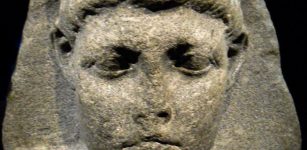Norse Goddess Sif Who Lost Her Golden Hair Due To Loki’s Evil Deed
A. Sutherland - AncientPages.com - Thor, the thunder god, had a beautiful wife, who was, along with the goddess Freya, the most attractive goddess in the Norse pantheon. Sif's characteristic feature was her golden hair, later replaced by a wig.
Thor loved his wife, who bore him two daughters, Lora and Thrud, famous for her strength.
Left: Goddess Sif. Image credit: Hedniska Tankar; Right: Loki cuts off all the hair of Sif. Katharine Pyle, 1930
Skaldic poetry and the Younger Edda by Snorri Sturluson, the "Skáldskaparmál" (the language of poetry), confirms that with his mistress (or his wife), Jarnsaxa, Thor had two sons, Magni and Modi. He was the stepfather of Ull (Uller), patron of winter, a handsome skier, skater, hunter, and an excellent archer. He is considered the son of Siv.
Sif was associated with the earth, passion, summer, and the sun. As responsible for the Norse people's crops, the goddess was also associated with vegetation and fertility. Her long golden hair was said to represent the long grass or the golden wheat covering the Northern summer fields.
Attested in the Poetic Edda (the Icelandic medieval manuscript known as the Codex Regius) and Snorri Sturluson's Prose Edda, Sif played a somewhat symbolic role in Norse mythology.
One story, however, is particularly well-known, and it tells about Sif's loss of her beautiful hair due to a mischievous prank of the trickster god Loki.
One day, Loki cut off all of Sif's long golden hair as she lay asleep. It was yet another of his bad jokes. When Sif woke up and discovered her loss in the morning, she was horrified and agitated.
As soon as Thor heard of Loki's betrayal, he was furious and threatened to break every bone in Loki's body.
Loki presents to Thor the newly-made gold-spun hair of Thor's wife, the goddess Sif. Gordon, Emma K (1910). The Gordon Readers, book 4
He knew that only Loki would have cut off Sif's hair.
'Well, what are you going to do about it?' demanded Thor. 'I'll replace it,' yelped Loki. I get help from the dwarfs. I promise to replace it.'
Loki Must Arrange New Hair For Sif
Seeing that Thor meant what he said, Loki swore to make up for his insult and immediately made his way to Svartalfheim, the underground home of the dwarves, excellent miners, and highly skilled craftsmen who extract and store precious metals and stones.
He would convince the dwarves to fashion Thor's wife a wig of golden hair.
The cunning god went to the cave of Ivaldi and his sons Brokk and Eitri and explained the reasons for his journey.
He begged them to make golden strands so natural that they would grow out of Sif's head, but he did not explain how Sif had lost her hair.
"Only you dwarfs are skilled enough smiths," Loki said, "and only the sons of Ivaldi could spin gold as fine as Sif's hair and imbue it with such magic that it will grow on her head."
"What will we get out of this?" was all that the sons of Ivaldi wanted to know.
"The thanks of Sif and Thor and the friendship of the gods," said Loki. "That counts for a great deal. And, above that, I give you my oath that I'll repay you in full measure when you have need of me."
The dwarves agreed to help him out of trouble, make a beautiful wig for Sif, and once again please the Aesir gods. The work was accomplished with their incredible magic. While the furnace was still hot, Loki persuaded Brokk and Eitri to make other magical treasures. One was the Skidbladnir, an indestructible ship that could be put in a pocket after folding, and the great spear Gungnir that flew straight to its target and never missed it.
Loki could carry these treasures back to the gods.
Sifs' new hair grew miraculously and was long and full, golden and sweet again. The story of Sif's hair being cut away symbolizes the golden wheat fields in the summertime that is shorn at harvest time.
In some interpretations, cutting off her golden hair, and shining in the sun, means the arrival of an infertile season or harsh wintertime.
Written by – A. Sutherland AncientPages.com Staff Writer
Updated on February 14, 2023
Copyright © AncientPages.com All rights reserved. This material may not be published, broadcast, rewritten or redistributed in whole or part without the express written permission of AncientPages.com
Expand for referencesReferences:
Elfwing J. Från ragnarök till ainulindalë
Davidson, Ellis H. R. Gods And Myths Of Northern Europe
Lindow J. Norse Mythology: A Guide to Gods, Heroes, Rituals, and Beliefs
More From Ancient Pages
-
 Dark History Of Pömmelte, The German Stonehenge – What Can The Nebra Sky Disc And Archaeology Reveal?
Archaeology | Jul 3, 2018
Dark History Of Pömmelte, The German Stonehenge – What Can The Nebra Sky Disc And Archaeology Reveal?
Archaeology | Jul 3, 2018 -
 Berserkers: Icelandic Viking ‘Mad Warriors’ In The Army Of God Odin
Featured Stories | Apr 25, 2017
Berserkers: Icelandic Viking ‘Mad Warriors’ In The Army Of God Odin
Featured Stories | Apr 25, 2017 -
 Mysterious White Chinese May Be Related To Ancient Roman Soldiers – Did Marcus Crassus’ Army Settle Down In The Gobi Desert?
Civilizations | Dec 29, 2017
Mysterious White Chinese May Be Related To Ancient Roman Soldiers – Did Marcus Crassus’ Army Settle Down In The Gobi Desert?
Civilizations | Dec 29, 2017 -
 Heliopolis ‘Sun City’ Was One Of The Most Ancient Cities Of Egypt
Featured Stories | Oct 6, 2021
Heliopolis ‘Sun City’ Was One Of The Most Ancient Cities Of Egypt
Featured Stories | Oct 6, 2021 -
 On This Day In History: Columbus Reached Honduras With His Ships – On July 30, 1502
News | Jul 30, 2016
On This Day In History: Columbus Reached Honduras With His Ships – On July 30, 1502
News | Jul 30, 2016 -
 Mysterious Greyfriars Kirkyard: A Cemetery In Edinburgh With Dark And Spooky History
Featured Stories | Sep 16, 2016
Mysterious Greyfriars Kirkyard: A Cemetery In Edinburgh With Dark And Spooky History
Featured Stories | Sep 16, 2016 -
 Pyramid Texts Of Ancient Egypt That Charted Journey Of Pharaohs Into Afterlife
Ancient Mysteries | Feb 26, 2020
Pyramid Texts Of Ancient Egypt That Charted Journey Of Pharaohs Into Afterlife
Ancient Mysteries | Feb 26, 2020 -
 18,000-Year-Old Seashell Was Musical Wind Instrument Used By Magdalenian People
Artifacts | Feb 11, 2021
18,000-Year-Old Seashell Was Musical Wind Instrument Used By Magdalenian People
Artifacts | Feb 11, 2021 -
 Neanderthals May Have Been Carnivores – New Study
Archaeology | Oct 17, 2022
Neanderthals May Have Been Carnivores – New Study
Archaeology | Oct 17, 2022 -
 Spectacular Giant Bronze Age Hall Found Near Berlin, Germany May Be Connected To Legendary King Hinz
Archaeology | Nov 6, 2023
Spectacular Giant Bronze Age Hall Found Near Berlin, Germany May Be Connected To Legendary King Hinz
Archaeology | Nov 6, 2023 -
 Magnificent Ancient Treasures Of The Mysterious Kangju Kingdom Found By Archaeologists
Archaeology | Jun 11, 2024
Magnificent Ancient Treasures Of The Mysterious Kangju Kingdom Found By Archaeologists
Archaeology | Jun 11, 2024 -
 Aristotelian Thought Is Being Revived In Lyceum – Ancient School Founded By The Greek Philosopher
News | Jan 30, 2023
Aristotelian Thought Is Being Revived In Lyceum – Ancient School Founded By The Greek Philosopher
News | Jan 30, 2023 -
 Athena – Goddess Of Wisdom Delivered Punishments And Gifts
Featured Stories | Dec 31, 2018
Athena – Goddess Of Wisdom Delivered Punishments And Gifts
Featured Stories | Dec 31, 2018 -
 Neanderthals Cared For Each Other And Survived Into Old Age – Study Shows
Evolution | Nov 2, 2023
Neanderthals Cared For Each Other And Survived Into Old Age – Study Shows
Evolution | Nov 2, 2023 -
 ‘Little Caesar’: Forgotten ‘King Of Kings’ Who Died Very Young
Featured Stories | May 11, 2020
‘Little Caesar’: Forgotten ‘King Of Kings’ Who Died Very Young
Featured Stories | May 11, 2020 -
 Deadly Catastrophe In Pompeii And An Overlooked Piece Of The Well-Researched Disaster
Archaeology | Jul 18, 2024
Deadly Catastrophe In Pompeii And An Overlooked Piece Of The Well-Researched Disaster
Archaeology | Jul 18, 2024 -
 Origin Of The Genetic Code – Study
DNA | Dec 16, 2024
Origin Of The Genetic Code – Study
DNA | Dec 16, 2024 -
 Hidden Structure Detected In Monte Albán, Ancient Metropolis Of Mexican Zapotec Culture
Archaeology | Dec 3, 2020
Hidden Structure Detected In Monte Albán, Ancient Metropolis Of Mexican Zapotec Culture
Archaeology | Dec 3, 2020 -
 Amergin: First Druid And ‘Wondrously Born’ Son Of Mil, Founder Of Poetry, Was Judge In Irish Mythology
Celtic Mythology | Mar 3, 2022
Amergin: First Druid And ‘Wondrously Born’ Son Of Mil, Founder Of Poetry, Was Judge In Irish Mythology
Celtic Mythology | Mar 3, 2022 -
 Giulia Tofana Poisoned 600 Men – Beautiful Sicilian Woman And Her Deadly Mission
Featured Stories | Feb 22, 2018
Giulia Tofana Poisoned 600 Men – Beautiful Sicilian Woman And Her Deadly Mission
Featured Stories | Feb 22, 2018


